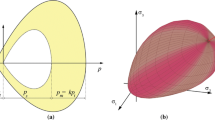Abstract
A recently proposed methodology for computational plasticity at finite strains is re-examined within the context of geomechanical applications and cast in the general format of multi-surface plasticity. This approach provides an extension to finite strains of any infinitesimal model of classical plasticity that retains both the form of the yield criterion and the hyperelastic character of the stress-strain relations. Remarkably, the actual algorithmic implementation reduces to a reformulation of the standard return maps in principal axis with algorithmic elastoplastic moduli identical to those of the infinitesimal theory. New results in the area of geomechanics included a fully implicit return map for the modified Cam-Clay model, extended here to the finite deformation regime, and a new semi-explicit scheme that restores symmetry of the algorithmic moduli while retaining the unconditional stability property. In addition, a new phenomenological plasticity model for soils is presented which includes a number of widely used models as special cases. The general applicability of the proposed methodology is illustrated in several geomechanical examples that exhibit localization and finite deformations.
Similar content being viewed by others
References
Borja, R. I. (1991): Cam-Clay Plasticity. Part II: Implicit integration of constitutive equation based on a nonlinear elastic stress predictor. Comput. Meth. Appl. Mech. Eng. 20, 225–240
Borja, R. I.; Lee, S. R. (1990): Cam-Clay Plasticity. Part I: Implicit integration of elasto-plastic constitutive relations. Comput. Meth. Appl. Mech. Eng. 78, 49–72
Chen, W. F.; Mizuno, E. (1990): Nonlinear analysis in soil mechanics-theory and implementation. Devel. Geotech. Eng. 53
Desai, C. S.; Somasundaram, S.; Frantziskonis, G. (1986): A hierarchical approach for constitutive modeling of geologic materials. Int. J. Num. Meth. Eng. 10, 225–257
Frantziskonis, G.; Desai, C. S.; Somasundaram, S. (1986): Constitutive model for nonassociative behavior. J. Eng. Mech. 112, 9, 932–946
Hill, R. (1950): The mathematical theory of plasticity. Dover editions, U.K.
Lade, P. V.; Kim, M. K. (1988): Single hardening consistitutive model for frictional materials II. Yield criterion and plastic work contours. Comput Geotech. 6, 13–29
Leroy, Y.; Ortiz, M. (1989): finite element analysis of strain localization in frictional materials. Int. J. Num. Anal. Meth. Geomech. 13, 53–74
Luenberger, D. G. (1984): Linear and nonlinear programming. Addison-Wesley, Menlo Park
Maenchen, G.; Sacks, S. (1964): The tensor code, in methods of computational physics, 3, 181–210. B. Alder, S. Fernback and M. Rotenberg Editors. New York: Academic Press
Moreau, J. J. (1977): Evolution problem associated with a moving convex set in a hilbert space. J. Diff. Eq. 26, 347
Oliver, J. (1989): A consistent characteristic length for smeared cracking models. Int. J. Num. Anal. Meth. Eng. 28, 461–474
Ortiz, M.; Leroy, Y.; Needleman, A. (1987): A finite element method for localized failure analysis. Comput. Meth. Appl. Mech. Eng. 61, 189–214
Ortiz, M.; Simo, J. C. (1986): An analysis of a new class of integration algorithms for elastoplastic constitutive relations. Int. J. Num. Meth. Eng. 23, 353–366
Roscoe, K. H.; Burland, J. B. (1968): On the generalized stress strain behavior of ‘wet’ clay. In: Heyman, J.; Leckie, F. A., (eds.) Engineering plasticity. Cambridge University Press, 535–609
Simo, J. C.; Taylor, R. L. (1985). Consistent tangent operators for rateindependent elastoplasticity. Comput. Meth. Appl. Mech. Eng. 48, 101–118
Simo, J. C.; Ju, J.; Pister, K. S.; Taylor, R. L. (1988): Assessment of cap model: Consistent return algorithms and rate-dependent extension. J. Eng. Mech. 114, 2, 191–218
Simo, J. C. (1988): A framework for finite strain elastoplasticity based on the multiplicative decomposition and hyperelastic relations. Part I: Formulation and Part II: Computational aspects. Comput. Meth. Appl. Mech. Eng. 66, No. 2, 199–219 and 66, No. 3, 1–31
Simo, J. C.; Kennedy, J. G.; Govindjee, S. (1988): Non-smoth multisurface plasticity and viscoplasticity. Loading/unloading conditions and numerical algorithms. Int. J. Num. Meth. Eng. 26, 2161–2185
Simo, J. C.; Rifai, M. S. (1990): A class of mixed assumed strain methods and the method of incompatible modes. Int J. Num. Meth. Eng. 29, 1595–1638
Simo, J. C.; Taylor, R. L. (1991): Finite elasticity in principal stretches; formulation and finite element implementation. Comput. Meth. Appl. Mech. Eng. 85, 273–310
Simo, J. C.; Miehe, C. (1991): Coupled associative thermoplasticity at finite strains. Formulation, numerical analysis and implementation. Comput. Meth. Appl. Mech. Eng. 98, 41–104
Simo, J. C. (1991a): Nonlinear stability of the time discrete variational problem in nonlinear heat conduction and elastoplasticity. Comput. Meth. Appl. Mech. Eng. 88, 111–131
Simo, J. C. (1991b): Algorithms for multiplicative plasticity which preserve the structure of the classical return mappings of the infinitesimal theory, SUDAM report No. 91-4. In press in comput. Meth. Appl. Mech. Eng.
Simo, J. C.; Hughes, T. J. R. (1991): Plasticity viscoplasticity and viscoelasticity: formalation and numerical analysis aspects, Springer-Verlag (in press)
Simo, J. C.; Armero, F. (1991): Geometrically nonlinear enhanced strain method and the method of incompatible modes. Int. J. Num. Meth. Eng. 33, 1413–1449
Simo, J. C.; Laursen, T. A. (1991): An augmented lagrangian treatment of contact problems involving friction. Computers and Structures 42, No. 1, 97–116
Vardoulakis, I.; Goldscheider, M.; Gudehus, G. (1978): Formation of shear bands in sand bodies as a bifurcation problem. Int. J. Num. Anal. Meth. Geomech. 2, 99–128
Wood, D. M. (1990): Soil behavior and critical state soil mechanics. Cambridge University Press
Wilkins, M. L. (1964): Calculation of elastic-plastic flow in Meth. Comput. Phys. 3, 211–272. B. Alder, S. Fernback and M. Rotenberg editors New York: Academic Press
Zienkiewicz, O. C.; Humphenson, C.; Lewis, R. W. (1975): Associated and nonassociated viscoplasticity and plasticity in soil mechanics. Géotechnique 25, 671–689
Author information
Authors and Affiliations
Additional information
Communicated by S. N. Atluri, February 18, 1992
Partial support provided by the Max Kade Foundation under Grant No. 2-DJA-616 and with Stanford University, and the Naval Civil Engineering Laboratory at Port Huaneme
Rights and permissions
About this article
Cite this article
Simo, J.C., Meschke, G. A new class of algorithms for classical plasticity extended to finite strains. Application to geomaterials. Computational Mechanics 11, 253–278 (1993). https://doi.org/10.1007/BF00371865
Issue Date:
DOI: https://doi.org/10.1007/BF00371865




